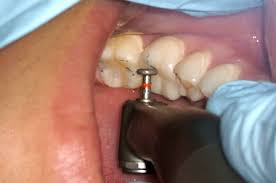 What Is an Occlusal Adjustment?
What Is an Occlusal Adjustment?
An occlusal adjustment is a dental procedure designed to correct your bite by reducing or preventing trauma caused by improper contact between the teeth. Even minor bite flaws might result in long-term issues with tooth fractures, jaw pain, and tight muscles.
Occlusal adjustment aims to reduce any interferences (i.e., to mediate the bite) by removing interferences where the teeth contact at the wrong angle. These changes are painless and are usually accomplished by using very special instruments.
There are two main types:
- Limited occlusal adjustment: Interferes with certain areas.
- Complete occlusal adjustment: A treatment known to be extensive, performed after orthodontic or restorative treatment.
When you are thinking about a limited occlusal adjustment or a complete dental bite realignment, the first thing that you must do is to go to a qualified dental practitioner to check your bite so that the correct course of action can be undertaken.
Why Occlusal Adjustment May Be Necessary
A dental bite adjustment may be required by an individual because of a number of factors. Wry bites are caused through:
- Dental restorations (e.g., crowns or fillings)
- Tooth loss or shifting
- Bruxism (chronic teeth grinding or clenching)
- Orthodontic treatment
- Trauma or injury to the jaw or face
When your bite is off, the symptoms can become more than just annoying. Patients can have:
- Headaches or facial pain
- Jaw discomfort or clicking
- Tooth sensitivity or worn enamel
- TMJ disorders
Negligible occlusion adjustments can be used by a dentist to alleviate the pressure, reestablish harmony between the bites and avoid future problems.
The Occlusal Adjustment Procedure
You may wonder how a bite adjustment is done? The process is accurate, fast, and usually painless. The procedure is like this:
- Bite Analysis: The dentist undertakes the above by first assessing your bite via an articulating paper and it reveals areas where there is initial contact with the teeth.
- Digital Scanning: Intra oral scanners (advanced technology) are used to construct an elaborate digital copy of your bite.
- Selective Reshaping: The dentist uses a limited amount of enamel at high points or hindrances by using his dental hand piece.
- Polishing: Modified parts are levelled and made glossy to enhance comfort.
- Rechecking: To make sure that balance has been accomplished, then the bite will be re-evaluated.
Look for a dental clinic that offers services in your area whether in a large city like Boston or a smaller community like Bel Air, MD. Many dental practices provide bite adjustment as part of their restorative or TMJ therapy services.
Occlusal Adjustment Dental Codes
Reading about the dental codes should explain how to get through the insurance coverage and care program. Current Dental Terminology (CDT) codes are used by dentists to communicate effectively with the insurers regarding the procedures used.
Common codes include:
- D9951: Occlusal adjustment – limited
- D9952: Occlusal adjustment – complete
These codes assist in the determination of your treatment if it is a specific area or a full bite adjustment. If you’re unsure, always ask your dentist which dental code they use for bite adjustment. When you visit the dentist in Bel Air, MD Dentist the front office will enable you to ensure your procedure is properly billed and documented.
Risks and Side Effects
Bite adjustment, similar to all other types of dental treatment procedures, may cause minor side effects. These may include:
- Temporary tooth sensitivity
- Slight bite discomfort for a few days
- Feeling of bite “unevenness” as the mouth adjusts
Exceptional complications can occur when excessive enamel is removed or the bite is over corrected. This is one of the reasons why you should follow-up with your dentist in order to check the status of your bite after the procedure.
Aftercare and Recovery
The healing from a bite adjustment is normally rapid and simple. This is what you can expect:
- There can be slight pain or tenderness
- Keep an eye on your bite and report any pain you experience
- Refute and come as needed for a follow-up appointment
When you experience constant discomfort or bite adjustments, make sure to reach out to your dentist in Bel Air, MD, and visit him again to make another assessment. Some small adjustments can be made to fine-tune the change.
FAQs
1. What is an occlusal adjustment in dentistry?
A bite adjustment refers to a dental practice whereby bite surfaces of your teeth are re-scheduled to address the abnormality of the bite. It assists in making your bite (occlusion) better by getting rid of high spots or interferences which may create discomfort, pain the jaw, or your teeth.
2. How is an occlusal adjustments done?
A dentist tests the contact with the help of articulating paper and removes minute slivers of enamel with the help of a dental handpiece. Digital tools for bite analysis can also be used. The process is painless and non-invasive.
3. What are the common dental codes for occlusal adjustment?
The most commonly used bite adjustment dental codes are:
- D9951: Limited occlusal adjustment
- D9952: Complete occlusal adjustment
These CDT codes help dental practices and insurers identify and classify the procedure accurately.
4. Is occlusal adjustment painful?
No, occlusal adjustment is not painful. Most of the patients feel little or even no pain because of this procedure, as in it only a slight thickness of enamel is taken out.
5. What are the side effects of an occlusal adjustment?
The side effects of bite adjustments are normally minimal, wherein there might be temporary tooth sensitivity or a small sense of bite inequality. Such symptoms tend to vanish after a few days.






